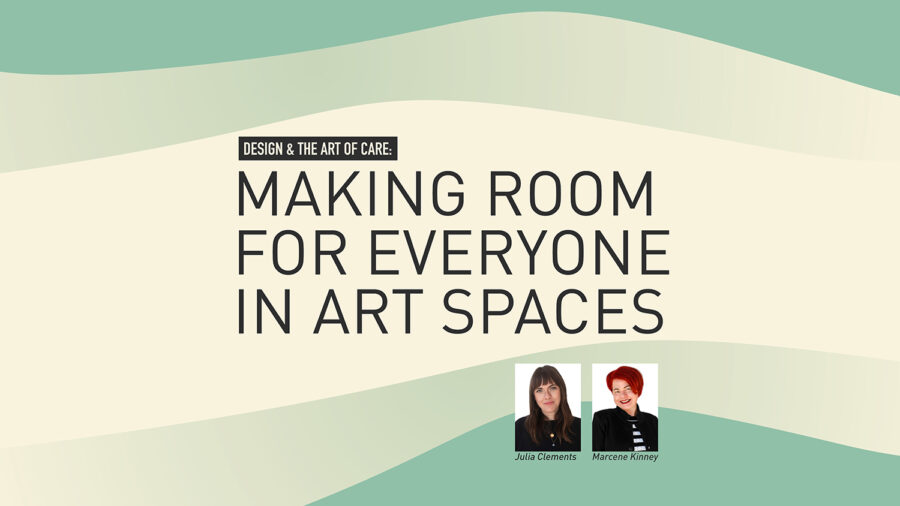Insights
Jun 6, 2023 _ insights
Design & the Art of Care: Making Room for Everyone in Arts Spaces

In a recent interview, LA-based curator and cultural strategist Antoine “AJ” Girard described his curatorial art in terms of care. Drawn to the magic that happens around the work of art—the shared revelation, the excited discussions, the joy in discovery—Girard almost describes curation as a form of hospitality. It’s a way of welcoming more people into the experience.
“Let’s make space for everyone to do their thing and be powerful,” he encourages us. We’re drawn to Girard’s advice because it reminds us of the importance of providing arts spaces where everyone can show up and feel welcome as their full, authentic selves.
Now more than ever, arts organizations are committed to creating inclusive spaces. From individual venues to national organizations like Broadway League and the American Alliance of Museums, there is an industry-wide effort to create arts experiences that are welcoming to diverse audiences.
To create a truly welcoming space, venues are right to center patron experience. This often takes the form of allowing all kinds of add-ons that one can purchase to curate their evening. Unfortunately, the design of the space is often overlooked. Yet, the space itself can be a powerful tool in helping to unlock enriching arts experiences.
Welcoming patrons is not an easy matter
Everyone comes with their own lived experiences, bringing with them the stresses and challenges of their lives. Arts venues should expect this and give people space—physical, emotional, and operational—to decompress, breathe, and settle in for a great night!
Imagine a self-conscious person: They might be nervous about the way they’re dressed or whether they’re conducting themselves appropriately. Other patrons might be unable to shake the stresses of work. When in this state, how can they let their guard down and open themselves up to the full depth of the arts experience? Providing a fully accessible experience means providing arts spaces where patrons can transcend the realities of their day, so they can join in the individual reflection and communal revelry the work of art or performance inspires.
DESIGN CAN DO THIS
Design should give a patron the physical and mental space to find comfort and security on their terms. Only then can they relax and be ready to enjoy their experience. This is especially true for patrons who have traditionally been marginalized within a cultural space (or who may not see many people like themselves in the lobby that evening).
If a patron is put at ease as they enter, they will be primed to get the most out of the performance. There are several techniques that design can employ to achieve this, but they all center on understanding how people inhabit public space.
 Entrances and lobbies are asked to do a lot in the hour before a performance begins. They must accommodate large crowds, seeing them through the processes of check-in/ticket scanning, security screening, accessing concessions, and finding their seats. But amidst all these highly functional activities, these spaces can also make their patrons feel welcome by helping them feel a sense of control over how they engage the gathering crowd.
Entrances and lobbies are asked to do a lot in the hour before a performance begins. They must accommodate large crowds, seeing them through the processes of check-in/ticket scanning, security screening, accessing concessions, and finding their seats. But amidst all these highly functional activities, these spaces can also make their patrons feel welcome by helping them feel a sense of control over how they engage the gathering crowd.
Providing a sequence of familiar routines can help a person navigate an unfamiliar facility. With the right materials, sequence of activities, and locations for amenities (e.g., elevators, toilets, and concessions), the lobby can create a sense of coherence and familiarity that will reduce a patron’s level of stress. As humans, we respond positively to nature. Architects and designers can leverage this calming influence with views to the outside, artwork, or through the selection of natural materials. Warm, soothing light can also promote comfort.
Lobby as a Landscape of Choice
Lobbies can provide psycho-social comfort and security for a diverse crowd by supporting common tendencies that people exhibit when inhabiting public space. Specifically, they can put visitors at ease by providing a range of perches and vantage points that enable them to engage socially on their own terms. We call this providing a “landscape of choice.” In what follows, we unpack this idea while illustrating it through the lobby at Cincinnati Shakespeare Company’s Otto M. Budig Theater.
CORNERS & EDGES
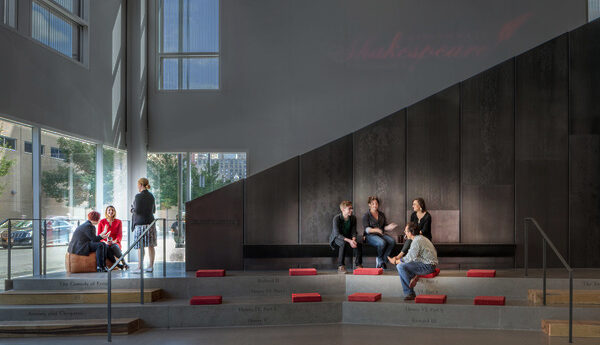
Corners and edges play a critical role in enabling people to gather comfortably. When given a choice in their environment, most people gravitate to corners and edges. These spaces are coveted because they make people feel safe. With a wall or corner behind them, patrons can survey their surroundings from a place that feels protected.
In healthcare design, this principle is known as “prospect and refuge.” It is used as a way of reducing stress. The same concept can be applied to the design of theater lobbies. Placed in an environment that is likely to be crowded and unfamiliar, the brain subconsciously perceives a lack of safety. The body reacts with heightened vigilance, which releases cortisol (the stress hormone). A well-designed lobby provides spaces to mitigate this reaction. For the unsure, the introverted, or those who need a little space to feel at ease in the crowd, these spaces are essential.
VANTAGE POINTS & ANCHORS
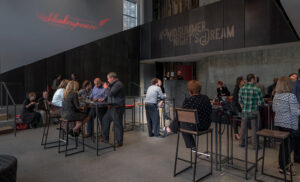
There are also several types of vantage points and anchors that let a patron find comfort by giving them a sense of control over how they interact with the environment and crowd. These choices let a patron find just the spot they like.
When a lobby is sparsely occupied an hour prior to a show, anchor points give a person physical support. A high-top table is a classic example. It lets a person occupy a larger physical footprint, helping them maintain a comfortable bubble of personal space. Like the experience of prospect and refuge offered by the corner, this satisfies a primal, subconscious desire for protection. Establishing this buffer enables a person to shift out of a heightened state of alert, so they better engage the room.
Temporary places to “perch” (like a bird), enable patrons to survey their immediate surroundings and engage in brief activities: making someone’s acquaintance, checking one’s phone, shuffling one’s personal belongings (purse, drinks, tickets, and program), or just taking a moment to rest (which is especially valuable to people who have mobility challenges). Perches satisfy a range of physical, social, and psychological needs.
VANTAGE POINTS FOR SEEING & BEING SEEN
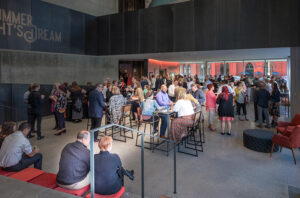
No venue has rivaled the Paris Opera House in elevating the desire to see and be seen. Spaces for this activity often include grand staircases and the center of the lobby. The important thing is that they offer good lines of sight to connect their inhabitants to others in the crowd.
Those who are drawn to these spaces skew toward the extrovert. They enjoy others knowing they are there! In many respects, for them, the process of arrival and all that pre-show buzz within the lobby is part of the performance. These positions also enable a number of active gestures that complement the process of “seeing and being seen” (knowing waves, eye contact with passersby, head tilts and smiles of acknowledgement, and excited conversations with old friends).
OVERLOOKS
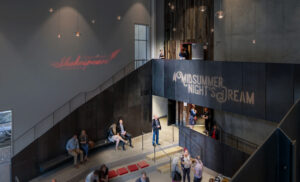
Often a place of enjoyment for the introvert, overlooks are removed from the fray of the crowd. They offer a quieter place where patrons can enjoy people-watching and private conversation. Sitting outside the bustling crowd, overlooks also offer a moment of respite for patrons with sensory processing issues.


An interior designer working across GBBN’s markets, Julia Clements works to bring physical and mental well-being into people’s everyday lives through the spaces they use. From concept to construction administration, she ensures health, wellness, and joy permeate every detail of a project.

As a Principal and Director of Arts at GBBN, Marcene Kinney, AIA, LEED AP uses architecture and design to create a sense of belonging, inclusion, and well-being in the arts. Her work includes the Taft Museum of Art Renovation, the Margaret and Michael Valentine Center for Dance, the Andrew J Brady Music Center, and the Cincinnati Art Museum’s Hanna Wing.
